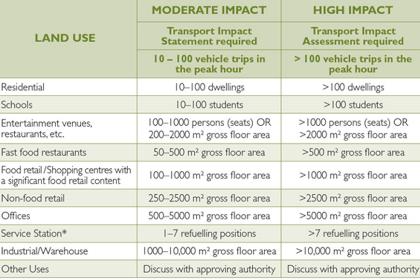Traffic Impact Assessment
The City assesses a large number of development applications each year. Applications are assessed under a planning framework that requires applicants to demonstrate compliance with relevant policies and procedures, and to establish that development proposals will not unreasonably impact upon the community and existing infrastructure.
When considering development applications, one of the assessments carried out by the City considers a development’s traffic impact. The Department of Planning, Lands and Heritage transport impact assessment guidelines set out the appropriate level of assessment required according to land use and size.
The below table from the Department of Planning, Lands and Heritage guidelines outlines when either a Traffic Impact Statement or a Traffic Impact Assessment is recommended.
Level of Traffic Impact Assessment required by land use and size 
While the City broadly supports the above, in line with its authority as the owners and operators of the local road network, it has determined that due to the high level of ongoing development within both the Canning Bridge and South Perth Station Precinct Activity Centres, any newly proposed development over three stories in these zones is to be determined as high impact.
All proposed developments over three stories in these zones require a Traffic Impact Assessment to be submitted, even when peak hour vehicle movements are less than 100.
Traffic Assessment Checklist
To streamline the application process and to increase the likelihood that all required information is provided by the applicant, the City has developed a Traffic Impact Assessment checklist.
The checklist is aimed at assisting applicants and their traffic engineers to prepare traffic impact assessment reports that are well aligned with the City’s requirements. It is expected that applicants will use the Traffic Impact Assessment (TIA) Checklist during the preparation of their reports. A completed copy of the checklist confirming that the various points have been considered and adequately addressed, should be included in the reports. Where any question is answered 'no' applicants should explain/justify why.
Benefits of the TIA Checklist
- Less time and effort required by the City’s officers to assess development applications
- Ensuring the assessment process best addresses community expectations
- Reducing delays in the overall development application assessment process
- Minimising the chances of traffic issues being escalated at JDAP or SAT hearings
The requirements listed in the checklist are in addition to all other requirements from the WAPC Guidelines, the requirements of the Town Planning Scheme No 6, the City’s Planning Policies, R Codes and Residential Design Guidelines, Australian Standards, AustRoads Guides and all other applicable planning and design documents.
The TIA Checklist should not be considered as a comprehensive list of all the points that will need to be considered. Each development application is unique and will present different challenges to be considered by the applicant, which may or may not be reflected in the checklist. The applicant’s use of the checklist aims to improve and expedite the assessment process, which will benefit all parties involved in the development assessment process.
The City reserves the right to peer review a TIA if deemed necessary. The applicant will be charged in line with the relevant Fees and Charges.
Traffic Data
In addition to the completion of a TIA, the City also requires the relevant report to include recent (last 12 months) traffic data on all roads abutting the proposed development.
If required, the City will provide this data and the applicant will be charged in line with the relevant Fees and Charges.
Traffic Impact Assessment Submission
The TIA checklist is available to download below and is to be supplied in addition to the final TIA. The document is available in an interactive format for people with Adobe Acrobat.
Please email the completed TIA to enquiries@southperth.wa.gov.au titled: Traffic Impact Assessment, with the development address included in the subject line.

